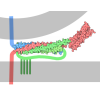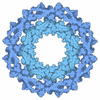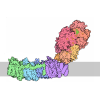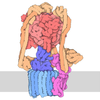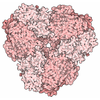+ Open data
Open data
- Basic information
Basic information
| Entry | Database: PDB / ID: 9ng2 | |||||||||
|---|---|---|---|---|---|---|---|---|---|---|
| Title | Y20S (Sec18-Sec17-Sec9-Sso1-Snc1) EDTA - Class 4 | |||||||||
 Components Components |
| |||||||||
 Keywords Keywords | TRANSLOCASE / SNARE / NSF / Sec18 / AAA+ | |||||||||
| Function / homology |  Function and homology information Function and homology informationDisinhibition of SNARE formation / vesicle fusion to plasma membrane / ascospore-type prospore assembly / inter-Golgi cisterna vesicle-mediated transport / RHOQ GTPase cycle / Retrograde transport at the Trans-Golgi-Network / RHOB GTPase cycle / RHOA GTPase cycle / vesicle fusion with Golgi apparatus / Golgi vesicle fusion to target membrane ...Disinhibition of SNARE formation / vesicle fusion to plasma membrane / ascospore-type prospore assembly / inter-Golgi cisterna vesicle-mediated transport / RHOQ GTPase cycle / Retrograde transport at the Trans-Golgi-Network / RHOB GTPase cycle / RHOA GTPase cycle / vesicle fusion with Golgi apparatus / Golgi vesicle fusion to target membrane / cellular bud / sporulation / trans-Golgi Network Vesicle Budding / soluble NSF attachment protein activity / prospore membrane / Intra-Golgi traffic / ascospore formation / vacuole fusion, non-autophagic / COPI-dependent Golgi-to-ER retrograde traffic / COPI-mediated anterograde transport / Golgi to endosome transport / COPII-mediated vesicle transport / SNARE complex disassembly / vesicle docking / SNARE complex / SNAP receptor activity / vesicle fusion / cellular bud neck / Golgi to plasma membrane transport / phosphatidic acid binding / intra-Golgi vesicle-mediated transport / mating projection tip / phosphatidylinositol-3,4-bisphosphate binding / Golgi to plasma membrane protein transport / Golgi stack / fungal-type vacuole membrane / retrograde transport, endosome to Golgi / phosphatidylinositol-3,5-bisphosphate binding / syntaxin binding / transport vesicle membrane / SNARE complex assembly / exocytosis / ATPase activator activity / autophagosome assembly / endoplasmic reticulum to Golgi vesicle-mediated transport / phosphatidylinositol-4,5-bisphosphate binding / Neutrophil degranulation / endomembrane system / SNARE binding / cell periphery / intracellular protein transport / macroautophagy / trans-Golgi network / autophagy / endocytosis / molecular adaptor activity / endosome / endosome membrane / Golgi membrane / Golgi apparatus / ATP hydrolysis activity / ATP binding / plasma membrane / cytosol Similarity search - Function | |||||||||
| Biological species |  | |||||||||
| Method | ELECTRON MICROSCOPY / single particle reconstruction / cryo EM / Resolution: 4.61 Å | |||||||||
 Authors Authors | Khan, Y.A. / Brunger, A.T. | |||||||||
| Funding support |  United States, 2items United States, 2items
| |||||||||
 Citation Citation |  Journal: Nat Struct Mol Biol / Year: 2025 Journal: Nat Struct Mol Biol / Year: 2025Title: SNARE disassembly requires Sec18/NSF side loading. Authors: Yousuf A Khan / K Ian White / Richard A Pfuetzner / Bharti Singal / Luis Esquivies / Garvey Mckenzie / Fang Liu / Katherine DeLong / Ucheor B Choi / Elizabeth Montabana / Theresa Mclaughlin ...Authors: Yousuf A Khan / K Ian White / Richard A Pfuetzner / Bharti Singal / Luis Esquivies / Garvey Mckenzie / Fang Liu / Katherine DeLong / Ucheor B Choi / Elizabeth Montabana / Theresa Mclaughlin / William T Wickner / Axel T Brunger /   Abstract: SNARE (soluble N-ethylmaleimide-sensitive factor (NSF) attachment protein receptor) proteins drive membrane fusion at different cell compartments as their core domains zipper into a parallel four- ...SNARE (soluble N-ethylmaleimide-sensitive factor (NSF) attachment protein receptor) proteins drive membrane fusion at different cell compartments as their core domains zipper into a parallel four-helix bundle. After fusion, these bundles are disassembled by the AAA+ (ATPase associated with diverse cellular activities) protein Sec18/NSF and its adaptor Sec17/α-SNAP to make them available for subsequent rounds of membrane fusion. SNARE domains are often flanked by C-terminal transmembrane or N-terminal domains. Previous structures of the NSF-α-SNAP-SNARE complex revealed binding to the D1 ATPase pore, posing a topological constraint as SNARE transmembrane domains would prevent complete substrate threading as suggested for other AAA+ systems. Using mass spectrometry in yeast cells, we show N-terminal SNARE domain interactions with Sec18, exacerbating this topological issue. We present cryo-electron microscopy (cryo-EM) structures of a yeast SNARE complex, Sec18 and Sec17 in a nonhydrolyzing condition, which show SNARE Sso1 threaded through the D1 and D2 ATPase rings of Sec18, with its folded, N-terminal Habc domain interacting with the D2 ring. This domain does not unfold during Sec18/NSF activity. Cryo-EM structures under hydrolyzing conditions revealed substrate-released and substrate-free states of Sec18 with a coordinated opening in the side of the ATPase rings. Thus, Sec18/NSF operates by substrate side loading and unloading topologically constrained SNARE substrates. | |||||||||
| History |
|
- Structure visualization
Structure visualization
| Structure viewer | Molecule:  Molmil Molmil Jmol/JSmol Jmol/JSmol |
|---|
- Downloads & links
Downloads & links
- Download
Download
| PDBx/mmCIF format |  9ng2.cif.gz 9ng2.cif.gz | 1.6 MB | Display |  PDBx/mmCIF format PDBx/mmCIF format |
|---|---|---|---|---|
| PDB format |  pdb9ng2.ent.gz pdb9ng2.ent.gz | 1.3 MB | Display |  PDB format PDB format |
| PDBx/mmJSON format |  9ng2.json.gz 9ng2.json.gz | Tree view |  PDBx/mmJSON format PDBx/mmJSON format | |
| Others |  Other downloads Other downloads |
-Validation report
| Summary document |  9ng2_validation.pdf.gz 9ng2_validation.pdf.gz | 2.1 MB | Display |  wwPDB validaton report wwPDB validaton report |
|---|---|---|---|---|
| Full document |  9ng2_full_validation.pdf.gz 9ng2_full_validation.pdf.gz | 2.1 MB | Display | |
| Data in XML |  9ng2_validation.xml.gz 9ng2_validation.xml.gz | 122.6 KB | Display | |
| Data in CIF |  9ng2_validation.cif.gz 9ng2_validation.cif.gz | 195.6 KB | Display | |
| Arichive directory |  https://data.pdbj.org/pub/pdb/validation_reports/ng/9ng2 https://data.pdbj.org/pub/pdb/validation_reports/ng/9ng2 ftp://data.pdbj.org/pub/pdb/validation_reports/ng/9ng2 ftp://data.pdbj.org/pub/pdb/validation_reports/ng/9ng2 | HTTPS FTP |
-Related structure data
| Related structure data |  49380MC  9cruC  9crxC  9n22C  9nluC  9nlwC  9nlyC  9nlzC  9nm1C  9nudC  9nueC  9nuzC  9nv0C  9nv1C  9nv9C  9nvdC M: map data used to model this data C: citing same article ( |
|---|---|
| Similar structure data | Similarity search - Function & homology  F&H Search F&H Search |
- Links
Links
- Assembly
Assembly
| Deposited unit | 
|
|---|---|
| 1 |
|
- Components
Components
-Protein , 5 types, 12 molecules ABCDEFGHIJKL
| #1: Protein | Mass: 84423.297 Da / Num. of mol.: 6 Source method: isolated from a genetically manipulated source Source: (gene. exp.)  Gene: SEC18, YBR080C, YBR0736 / Production host:  #2: Protein | Mass: 32899.828 Da / Num. of mol.: 3 Source method: isolated from a genetically manipulated source Source: (gene. exp.)  Gene: SEC17, YBL050W, YBL0505, YBL0517 / Production host:  #3: Protein | | Mass: 10943.198 Da / Num. of mol.: 1 Source method: isolated from a genetically manipulated source Source: (gene. exp.)  Gene: SNC1, YAL030W / Production host:  #4: Protein | | Mass: 30798.027 Da / Num. of mol.: 1 Source method: isolated from a genetically manipulated source Source: (gene. exp.)  Gene: SSO1, YPL232W, P1405 / Production host:  #5: Protein | | Mass: 25777.920 Da / Num. of mol.: 1 Source method: isolated from a genetically manipulated source Source: (gene. exp.)  Gene: SEC9, HSS7, YGR009C / Production host:  |
|---|
-Non-polymers , 2 types, 11 molecules 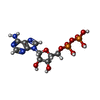
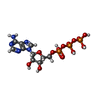

| #6: Chemical | | #7: Chemical | ChemComp-ATP / |
|---|
-Details
| Has ligand of interest | Y |
|---|---|
| Has protein modification | N |
-Experimental details
-Experiment
| Experiment | Method: ELECTRON MICROSCOPY |
|---|---|
| EM experiment | Aggregation state: PARTICLE / 3D reconstruction method: single particle reconstruction |
- Sample preparation
Sample preparation
| Component | Name: Y20S complex EDTA / Type: COMPLEX / Entity ID: #1-#5 / Source: RECOMBINANT |
|---|---|
| Source (natural) | Organism:  |
| Source (recombinant) | Organism:  |
| Buffer solution | pH: 8 |
| Specimen | Embedding applied: NO / Shadowing applied: NO / Staining applied: NO / Vitrification applied: YES |
| Vitrification | Cryogen name: ETHANE |
- Electron microscopy imaging
Electron microscopy imaging
| Experimental equipment |  Model: Titan Krios / Image courtesy: FEI Company |
|---|---|
| Microscopy | Model: TFS KRIOS |
| Electron gun | Electron source:  FIELD EMISSION GUN / Accelerating voltage: 300 kV / Illumination mode: FLOOD BEAM FIELD EMISSION GUN / Accelerating voltage: 300 kV / Illumination mode: FLOOD BEAM |
| Electron lens | Mode: BRIGHT FIELD / Nominal defocus max: 1800 nm / Nominal defocus min: 800 nm |
| Image recording | Electron dose: 50 e/Å2 / Film or detector model: GATAN K3 (6k x 4k) |
- Processing
Processing
| CTF correction | Type: NONE | ||||||||||||||||||||||||
|---|---|---|---|---|---|---|---|---|---|---|---|---|---|---|---|---|---|---|---|---|---|---|---|---|---|
| 3D reconstruction | Resolution: 4.61 Å / Resolution method: FSC 0.143 CUT-OFF / Num. of particles: 26603 / Symmetry type: POINT | ||||||||||||||||||||||||
| Refinement | Highest resolution: 4.61 Å Stereochemistry target values: REAL-SPACE (WEIGHTED MAP SUM AT ATOM CENTERS) | ||||||||||||||||||||||||
| Refine LS restraints |
|
 Movie
Movie Controller
Controller



















 PDBj
PDBj